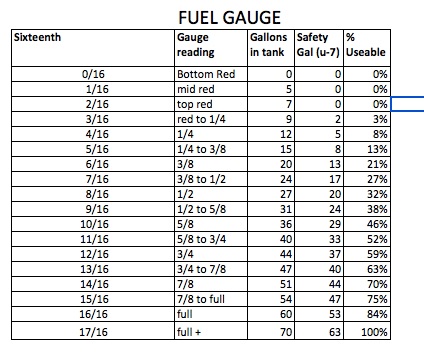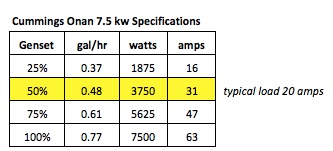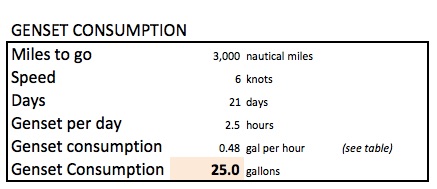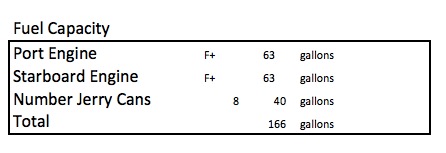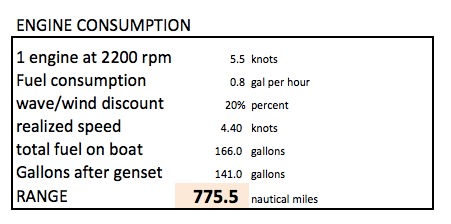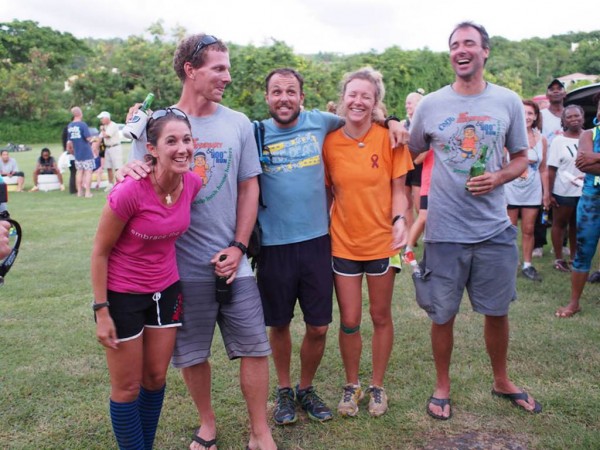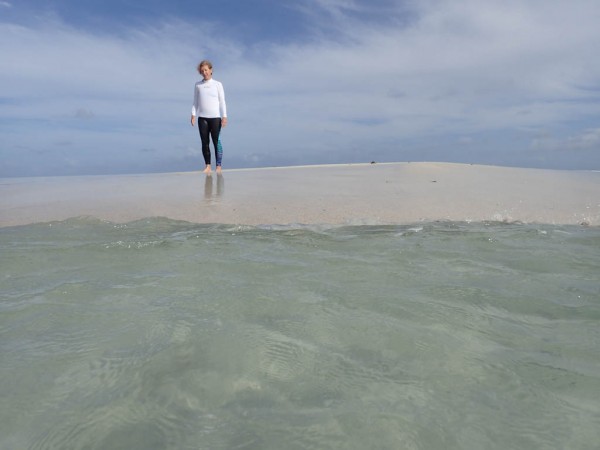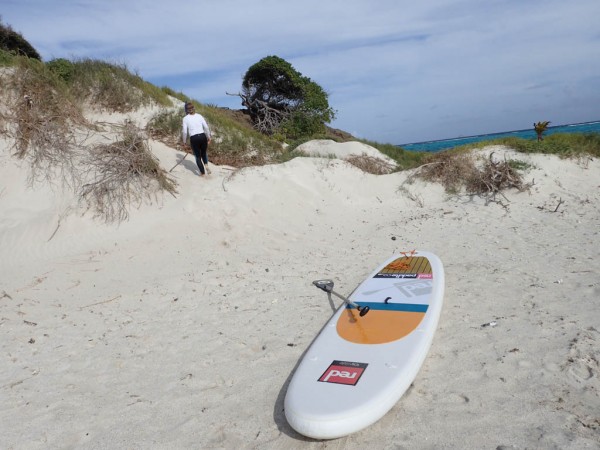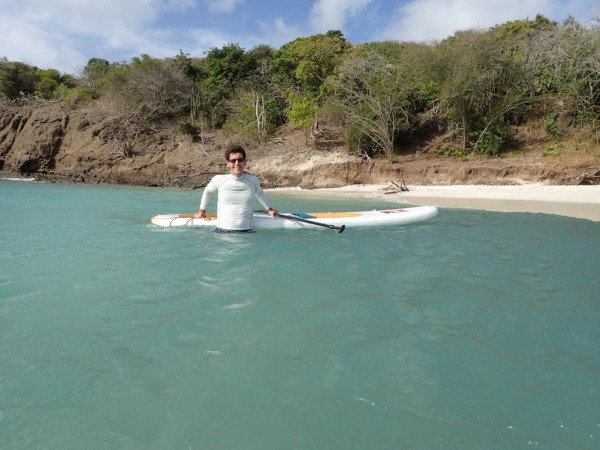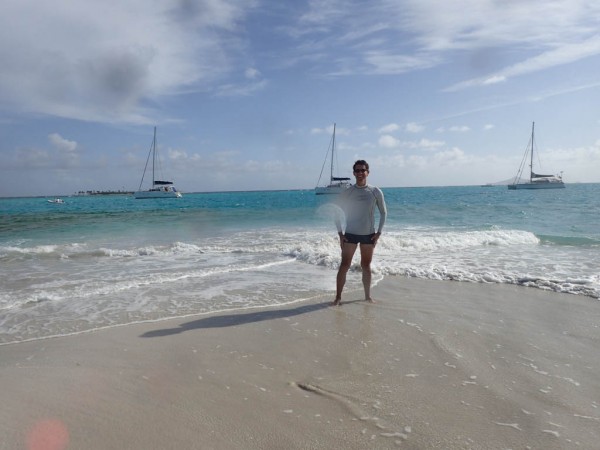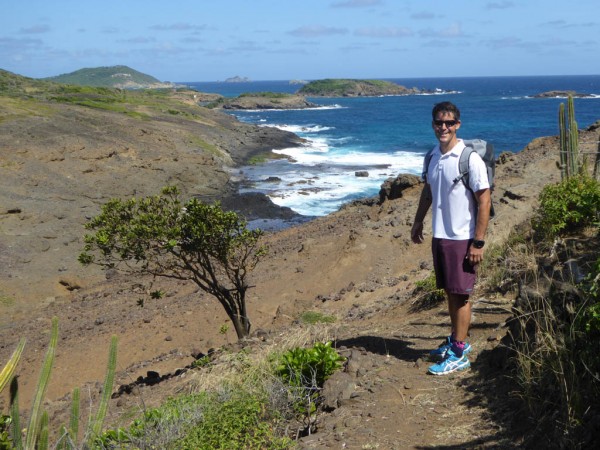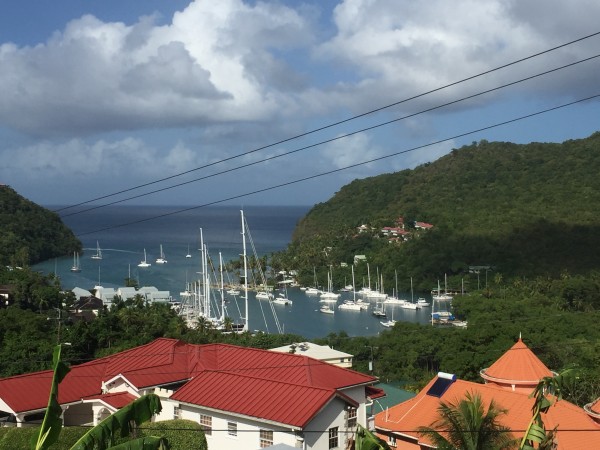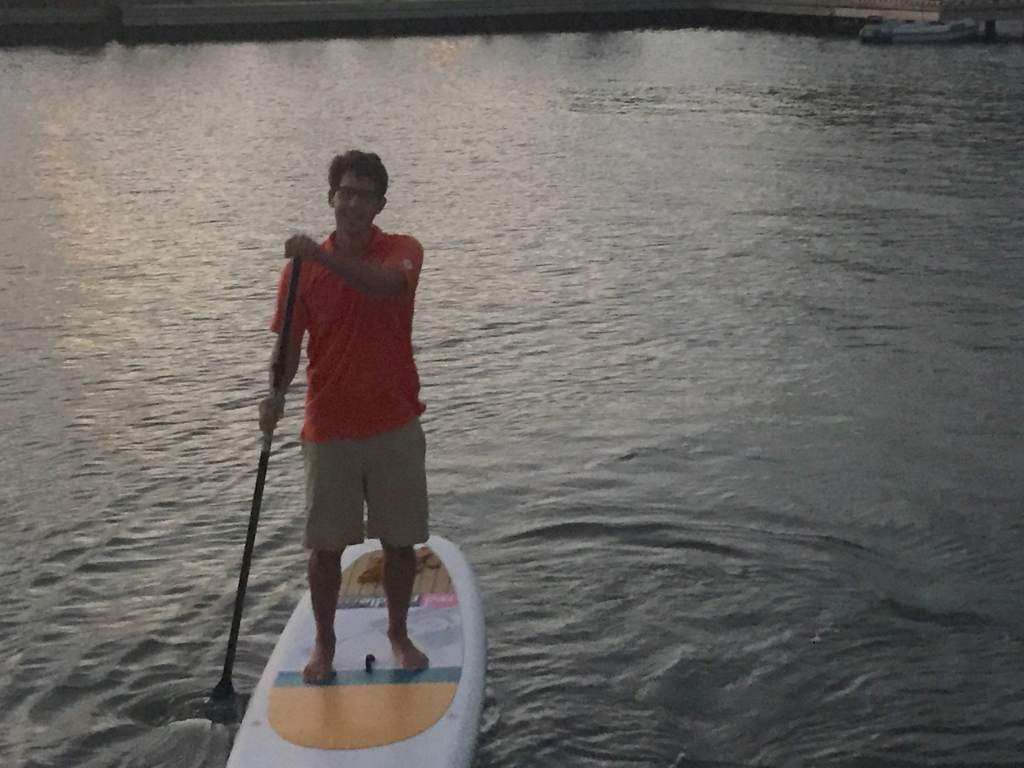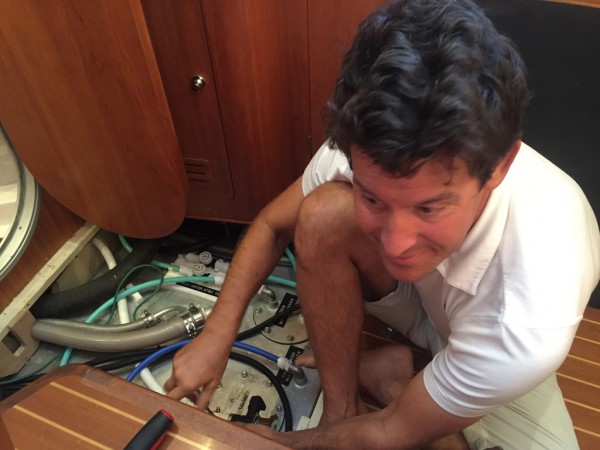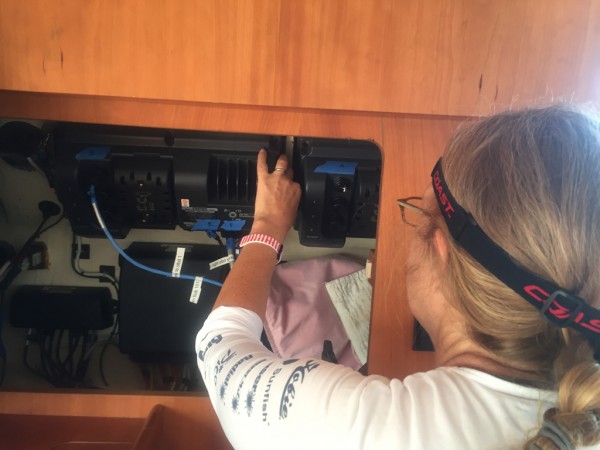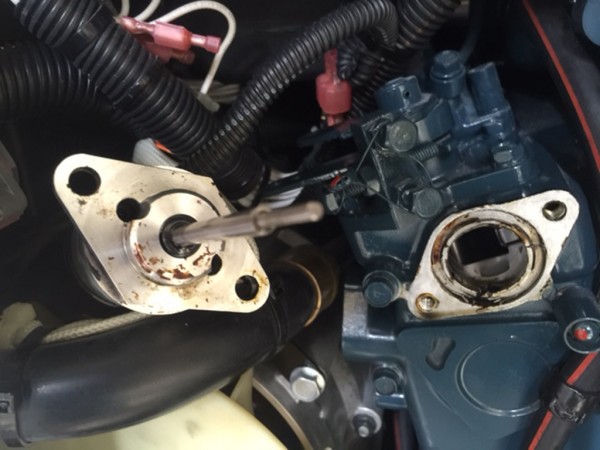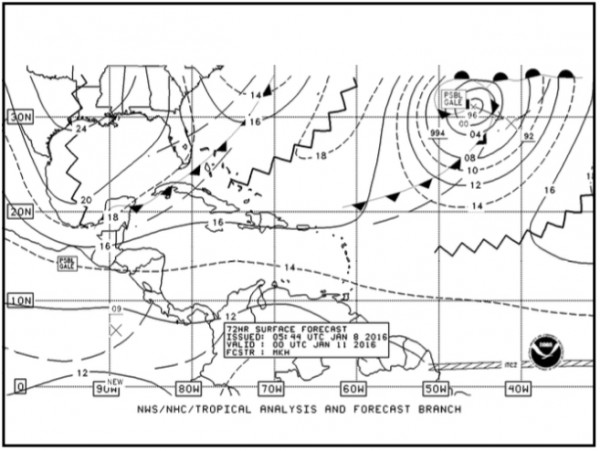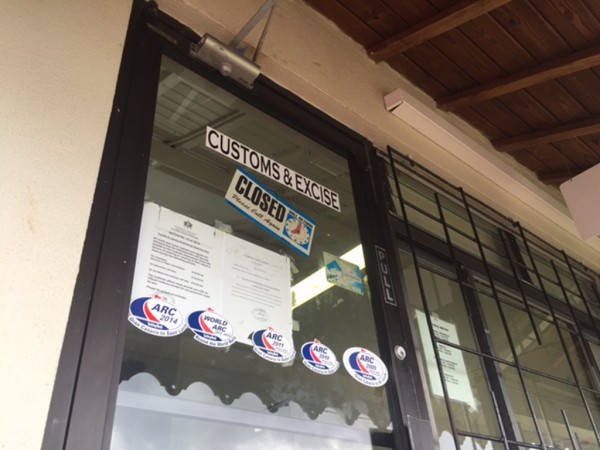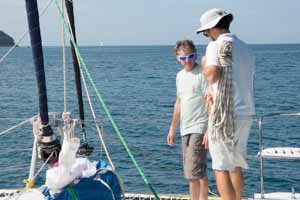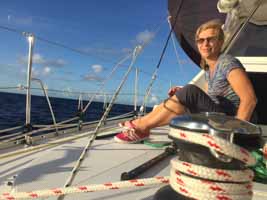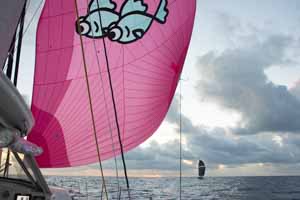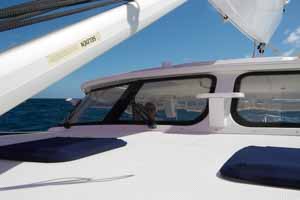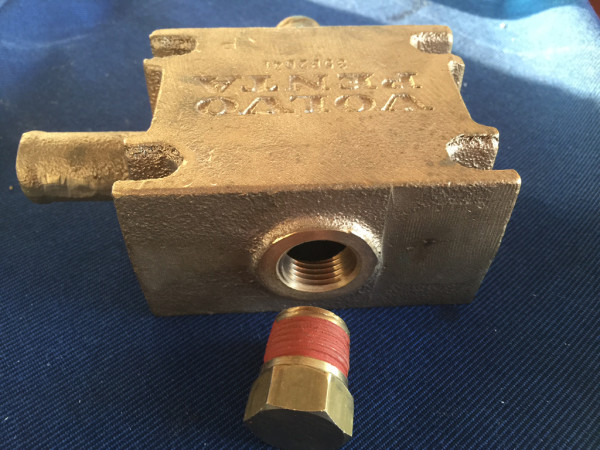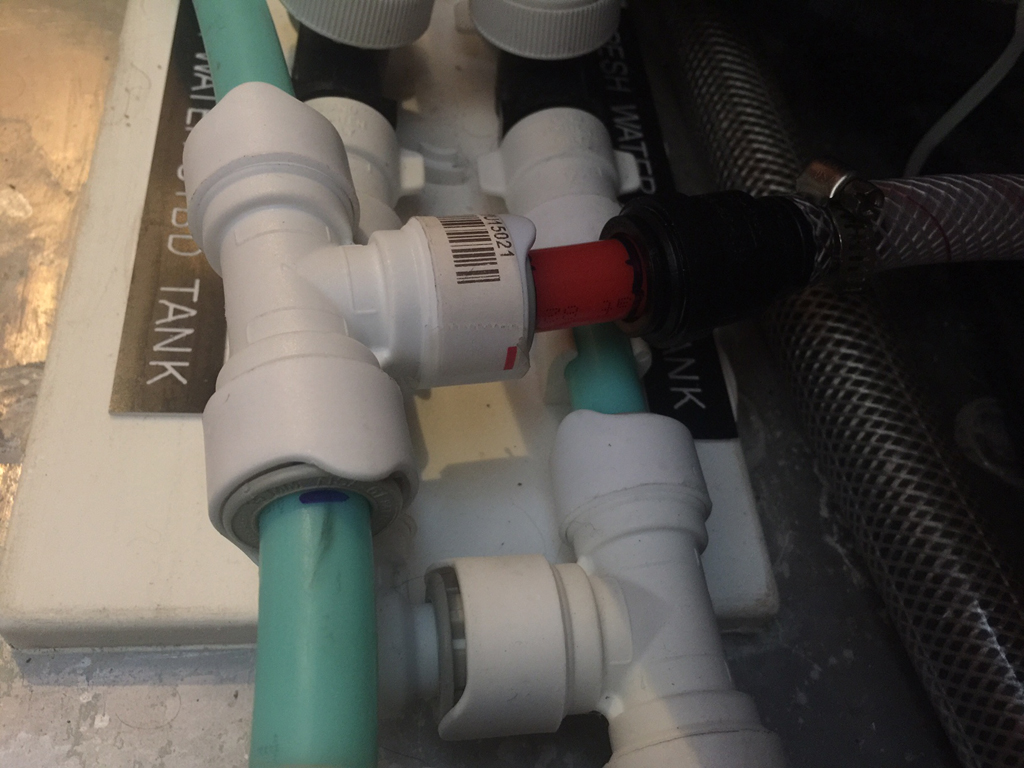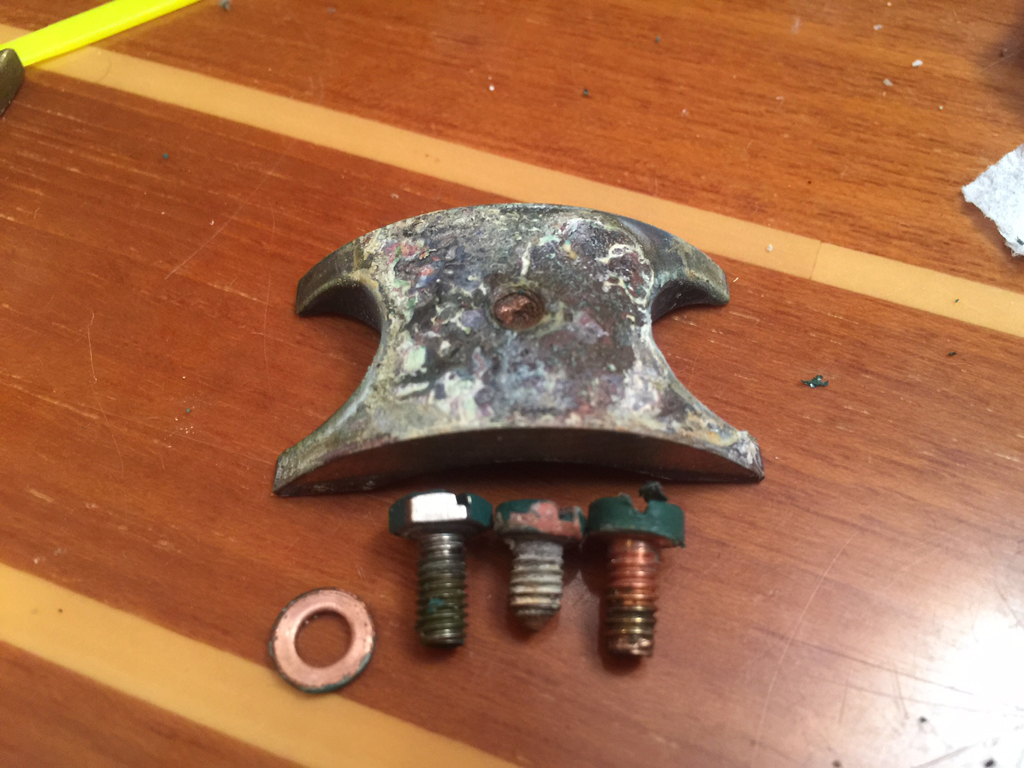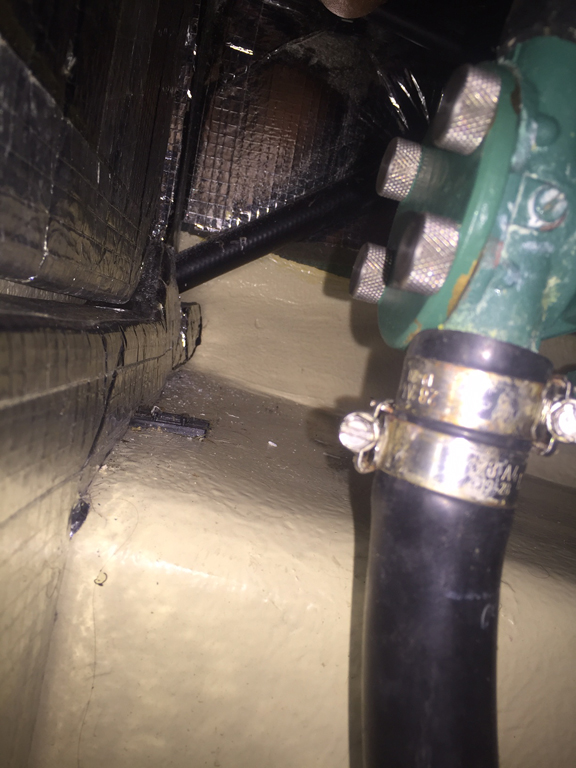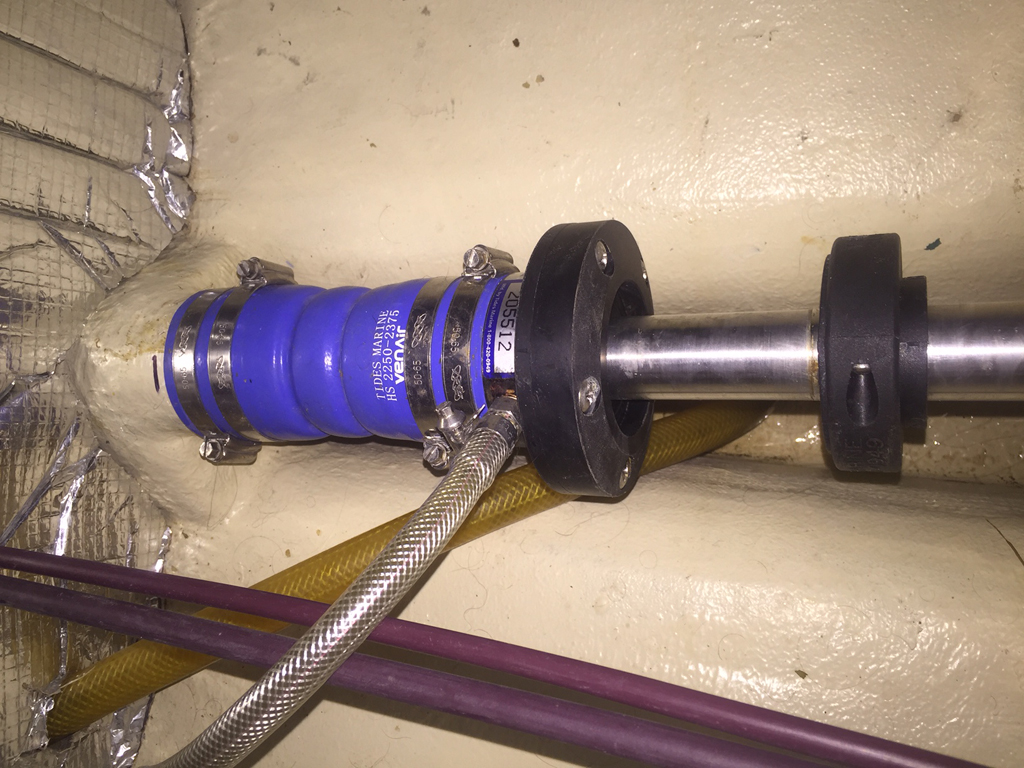If Dante had owned a yacht, he would have made boat yards one of the levels of hell. Grenada Marine is carved out of the lush jungle and thus is prime real estate for mosquitos, no-see-ums and see-ums. You can carbon date a stranger’s time in the boat yard based on their number of bug bites. Five per leg per day is my rough calculation. 
The boatyard’s customs agent is a bozo. To bring in parts for the boat you must leave them at the airport so they can collect a 2.5% tax. This creates little revenue but has created much consternation. I will skip the speech on the merits of government. The customs agent told us the bag would stay at the airport for only one night but we are now hoping the bag will arrive day four
.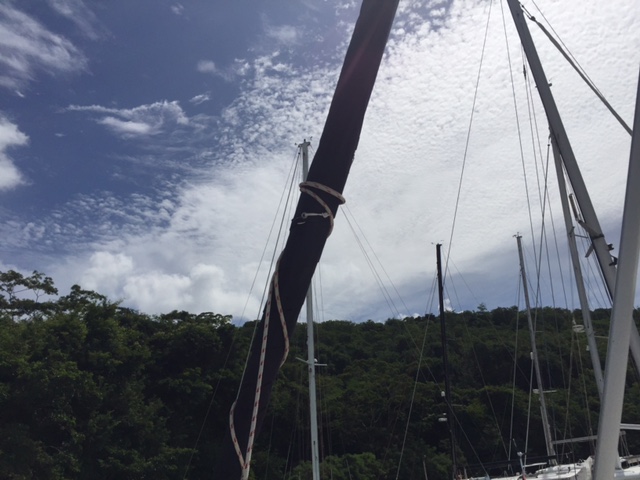
Our projects have gone well and we are ready to splash in the morning. We hired the yard to clean the decks but they went a bit too far. They removed the cover for the instruments and hosed them down. This is not a great combo and now a screen has a water droplet trapped inside. One step forward and two steps backwards in the boat yard. We must achieve escape velocity or we will be trapped in the un-numbered level of hell.
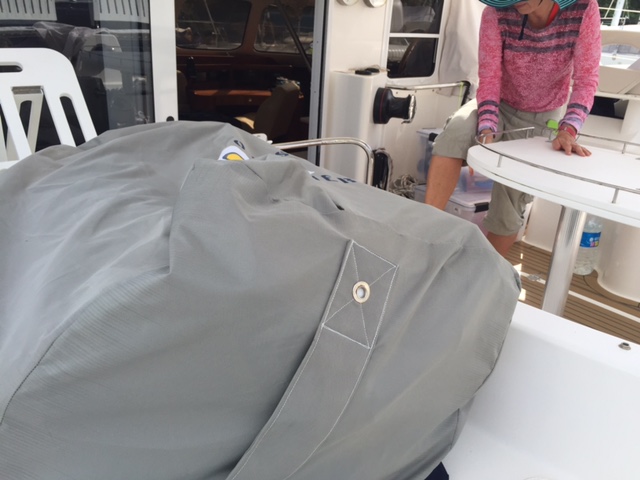
Did I just complain about our great life/ Oops. Sorry, as I am sure work, traffic etc, gave everyone enough headaches today.
Boat Yard Blues
Fuel Management
Our last two major cruises were motoring on the ICW (InterCoastal Waterway) and sailing along the Caribbean chain. On the ICW, diesel is easier to find than a NYC Bagel. During our 6 months sailing south in the West Indies we used the engines for fewer than 40 hours. In both cases, fuel plans were not needed.
Our next adventures will involve long distances (3,000 miles from the Galapagos to the Marquesas), no or unreliable quality diesel (Tuamotos) and possibly light air (Bay of Panama). As is my usual habit when solving problems, I created a spreadsheet to investigate further.
Fuel gauges vary in their accuracy. I have heard that air pressure gauges and electrical sound gauges are very accurate. We have traditional WEMA float gauges, which offer a suggestion of the amount of fuel in the tank rather than a definitive statement. Also, we never push it close to empty to ensure that the engine does not suck in bottom-of-the tank gunk. I should have more faith in my multiple fuel filters.
Conservatively, (7 gallons in reserve) we have 63 gallons of diesel capacity in each tank. The builder claims 75 gallons; that may be correct if you draw out the last ounce of diesel.
At anchor, Two Fish’s batteries require very little charging since the solar panels cover the lights and other anchor based consumption. We tend to run the genset every 3 days for about 1.5 hours. However, during passage our consumption skyrockets. The solar produces 20 -30 amps for the sunny parts of the day, but the boat relentlessly consumes 21 amps every hour, whether the sun is up or down. 8 amps for the fridge and freezer, 7 amps for the navigation screen, 4 amps for the beefy autopilot and radar; other assorted bits fill in the balance.
Two Fish and other Antares boats will run their genset for 2.5 hours a day when on a 100% multiday sailing passage. To reduce the hours, I purchased a Watt & Sea hydro generator. It looks like a rudder from a sailing dinghy with a propeller attached. So far, the results have been okay. It is too early for a final verdict. The boat does not seem to travel any slower with the hydro on, so it is kind of free energy. The marketing materials are rather optimistic. The hydro can be fitted with 3 different size propellers. We fitted the largest size. It produces in the real world what the marketing gurus say is the medium size propeller’s amps. At six knots (a speed we exceed most of the time) the hydro can produce between 5 and 10 amps. This is a game changer as it replaces 1.5 to 3 hours of genset time. We might only need the genset for the watermaker! The hydro will produce almost no energy at 4 knots and at 12 knots it cuts out.
This is the plan for our 3,000 mile leg, assuming no hydro amps. Without any type of rationing, assuming a 21 day passage, we would consume 25 gallons, or 20% of our fuel by running the 2.5 hour top-up. All hail hydro.
When the wind becomes light the engine typically fills in for the loss in speed but on a long passage you have to ration your fuel.
What is the magic number of jerry cans to carry? 8 cans can fit nicely in the cockpit locker. I like to keep the weight out of the bow and stern and this has proven a convenient location when they need to be accessed. If 8 cans is not enough then tying extra cans under the cockpit table. They are not too annoying for folks sitting at the table and can be secured well with a few lines. It is a large boat and there are plenty of places to hide cans. I once put 17 cans on Two Fish and she does not sail well with that much weight. The waves are more uncomfortable and the performance is ruined. However, 8 cans and I did not notice any change.
Our usual one engine, 2200 rpm motoring speed burns .8 gallon/hour has a range of 775.5 nautical miles. That is conservative since we give no credit for the hydro generator, no bonus for motor sailing, and reduce speed by 20 percent for bad waves and wind. More realistically, over 1,000 miles is possible. In an emergency that number could double if you sacrificed speed and ran the engines at lower rpms.
I need to end this post before I become a motor boat head. Our new screecher headsail should power us up better than the engines. Next post should be about sail trim?
One More Cruise
Before leaving the Caribbean, we were eager to put boat work aside and enjoy a bit more of the Windward Islands. We will miss Grenada and the weekly hashes but hope to see some of our cruising friends again.
Fortunately, Beth and David found some time in their schedules for a one week cruise from Grenada to St Lucia. As much as we like and will miss Grenada, we were excited to push off towards the Grenadines.
I am not sure how much our guests appreciated the favorable breezes during our one week cruise. After last season’s continuously breezy upwind conditions, we were lucky to sail with the wind behind us, of course trying out every sail along the way.
At one point, we almost mutinied when Jason’s adherence to keeping the screecher up had us headed, albeit quickly, towards Nicaragua. Or maybe he was going to bear off more and start the trip to the canal?
Tobago Cays was beautiful but not the snorkeling paradise I was hoping for; while the winds were not howling, they were enough to muddy the waters.
Mustique proved to be my favorite Grenadine, yet again.
David reminded us that our best chance of catching a fish was to invite him aboard. He caught three tunas that week. Not only is he an expert fisherman but he provides sea to table cuisine; he served up delicious ceviche, bbq tacos and seared tuna.
Did I say no boat work for the week? Well, almost. We managed to squeeze in a fix to the furler, the door latch and an attempted fix to our water heater pressure relief valve.
Marigot Bay beckoned with flights home and Fed Ex’ing our chartplotter for rapid repair. It is fun to return to places we have been before and we again enjoyed the food at Masala Bay, Christmas Eve dinner at the Rainforest and daily workouts at Capella’s gym.
I wanted to try the local bakery, to see if they had any St Lucian holiday treats. I walked up the hill and couldn’t see any sign for a
bakery. I asked a shopkeeper where the bakery was and she pointed down the hill and told me it was just past the blue van, just as the blue van started pulling away. I walked down the road and asked a man who told me it was up
the road, just past the mango tree. I was too embarrassed to tell him that I had no idea what an out-of-season mango tree looked like and that my usual mango tree is in the fruit aisle at Fairway. I finally found the shop and bought some ginger cookies and coconut bread.
Now we have returned to Rodney Bay and the countdown to our departure towards the canal and points west begins.
Day Minus One
We will set sail from Rodney Bay, St Lucia towards Santa Marta, Colombia, in the morning.
This five day passage is the first leg in our trip to Australia. It would have been cheaper and quicker to buy two first class airline seats, but this will be a lot more fun.
I feel a bit more pressure than average passage for a few reasons. Firstly, we have joined a rally with other boats and this creates more rules and timelines. I will get used to it over time. Secondly, we are going on a L O N G trip. It is 12,500 from St Lucia to Australia. In the past 2 years we have sailed 12,400 miles so we will be under sail many of the days. About 2,100 hours or 86 days of sailing in the next year. Good news is we have a kind forecast for our trip to Colombia.
Gail has cooked up a storm so we have eight frozen dinners (Chili, Baked Ziti, Lentil and Chicken Couscous x 2). We plan on inviting some fish over for dinner as well. We found some new invitations at the hardware store earlier this week.
Over the past few weeks, we have readied Two Fish for the Pacific. The engines were gone over with a fine tooth comb and had their share of fixes. Every filter has been changed. Every system tested. Oil changed. Even a wood squeak was removed from port forward. The stuck fuel filter on the genset was changed and the leaky gasket on the governor was replaced.
In addition to our usual chartplotters, we have collected a few more resources for navigation:
1) We have downloaded Google Earth for offline use for our entire trip. It takes up about 25 gigabytes of room. It has good spots and some weak spots. We use the app Tallon on the PC to download regions. Our files seem to work only on Windows 8.1.
2) We have many great tracks from other boats. We load these gpx files onto our chartplotter and into Google Earth.
3) We have made some of our cruising guides into raster charts that I can use on the tablet. I use SeaClear II and Map Cal to create these charts. We are trying to buy a tablet holder to keep near the helm.
We will write more about our navigation as we progress through our route.
The ARC group (our rally) is still feeling its way. Some boats are veterans of sailing in rallies, others are getting ready for their first big passage and others, like us, are loners trying to adjust to the pace. We will find our stride, but for now I have to bite my lip a few times. Tonight is a leaving party and by morning I will be at sea where I belong. The rally has a start line, which I expect will create some high blood pressure. I am not sure how many boats know the racing rules, so I will try not to win the start.
Day one
At some point this post will be 12,500 nautical miles in our wake. Right now we are close enough to St Lucia that VHF from the marina can still be heard. We are cutting the tentacles to the familiar at a slow rate.
We set up for the pin end of the start line and crossed in 4th. However committee end was hugely favored and we were rolled by a big chunk of the boats while we switched from the Genoa to the screecher. Black fish got us back in the game and we passed a few boats. But the horror show rally folks had put a turning mark in Castries bay. Which had winds of 6 knots and upwind. Screecher down and Genoa back up. More boat lengths gone. Fun rounding at the mark as we came in on starboard and Paw Paw ducked us. Chute went up in crushing style. I rigged the sheet wrong 3 times.
Banana bread was broken into and the hydro gen is making amps and a relaxed humming noise. The winds are light and a few of the boats have sparked up the engine. One of our two sisterships is near by and the other coming from Martinique.
Gail is helming and the chute is pulling us west. What could be better? Dinner time and that is soon. Out for now.

Jason
+1 646 510 3500
day two
Rally Start Photo
We are on the gerbil wheel! The gerbil wheel is a Two Fish sailing term describing the phenomenon of never changing arrival time. For the last 12 hours we have had 4 days to go. No one is complaining and some secretly wish this trip to last forever as the wind and waves have been kind. We have both the chute and the screecher flying in 12-13 knots and making 6 to 7 knots SOG. The current is contributing half a knot to our progress.
Gail’s banana bread day’s are numbered. Despite it have stayed in the oven 5 minutes too long it is darn tasty. Thanks for the recipe M/V Barefeet (formerly known as PDQ SV Barefeet). Gail has started 20,000 leagues under the sea and asking me odd questions with four letter answers so she must be doing the crossword puzzle. James and Jackie are fitting in quickly. Jackie was worried about night watches but seems to take to them like a jib to a furler. Tonight we will be flying our double headsail rig as long as the breeze does not shift more to the south. If it does go south we will roll up the screecher and raise the main and steer a 140 true wind angle course.
Sailing west makes easy sailing math. You are heading 270 and the wind is from 90. Big numbers (i.e. greater than 90) be on port jibe and small numbers (i.e. less than 90) be on starboard jibe. We are breaking the rule and taking the comfy but slower approach of DDW. I feel guilty saying it in public.
The SSB worked like a champ. We dialed into the daily call and heard almost everyone and they seemed to hear us. It is still rather mystical how it works, not the best user interface. It was great to hear from the other boats. Some caught yellow fin tuna, others abstained from any motoring, one break a gooseneck and many boasted of great breakfasts. We stuck to the facts of wind speed and sail plan. The boat leading the call did a brilliant job. Sound
Just read the marina in Colombia uses finger print scanners. Do I want them to have my finger prints?
Day Three – First discussion of Landfall
Location: 500 miles until Santa Marta, Colombia, far off the Venezuelan Island of Tortuga.
We have avoided Venezuela because of its reputation for crime. It is a shame to miss this country as many cruisers have told me of the beauties of the coastal islands. I hope to return some day.
Foolishly, I brought up the topic of landfall and my preferred time of day. This hubris will be punished by the wind gods or their friend the WGM (wave generating machine). Both can be bitter and spiteful. Our case is being heard by the court as we still have grand conditions for downwind sailing. These are the conditions that sell boats and appear in magazines.
Before leaving St. Lucia I tried to share my many navigational gems but have had just a few takers so far. I will mention my offer on the fleet SSB (ham radio) call tonight. For two years, I have bemoaned owning an SSB. It took us a while to be comfortable with the technology, but now I am sold. The fleet is widely dispersed, precluding VHF calls, but with the SSB the fleet can share news. “Take Off”, a Swedish Elan 41, with a carbon fiber rig, broke their boom. All on board are safe and they now are flying only a head sail. A boom is one of the few spare parts Gail did not pack. A few boats have caught fish and one was inquiring about the safety of eating barracuda. When we catch Barracuda, we release them.
Last night Two Fish was the exception in the fleet, as many chose to motor through the light winds. The twin headsail kept us going, but those motoring closed the gap. As we head west the breeze will build but remain light enough to allow Gail to make sandwiches. Tonight is Gail’s famous lentil dish. Everyone loves it or walks the plank.
We have made a couple of strategic choices and I think I choose poorly, but time will tell.
1) The current is not a simple east to west. There are back eddies and I think we may have tripped on one listed in our charts. I should have know better that closer to the coast would be a kinder current.
2) In patchy winds it is fastest to sail under clouds. But yesterday we were under blue skies and had less wind than other boats. It took us 5 hours to reach our first cloud.
3) I have been hugging the rhumbline (direct route) in a decision of indecision. We have been DDW with chute and screecher. It has been a comfortable ride and that avoids mutiny.
Repairs at sea
James fixed so many gremlins before leaving the dock that we have been lucky so far at sea. A few that cropped up were:
1) The pin that holds the hydro-generator began to slip out on Gail’s watch. Gail and I dropped the two headsails and in true McGail-Guyver fashion used her hair tie to secure the pin. I will upgrade this to a proper line in the future. The sail changes went very smoothly.
2) We had a false alarm that our AIS was not working, but it seems fully functional.
3) We need to adjust the screecher tack when in port. Installed 180 degrees off (Jason’s mistake).
All other systems just fine for now.
Day 5, What happened to Day 4
13 Jan Offshore from the Colombian / Venezuelan border
The days are blending together faster than margarita ingredients in a dive bar. We had a fire drill on board. The spinnaker halyard goes through a block at the top of the mast. This block is attached by a single screw as it expects only a downward load. We luffed the chute a few times too many and the bolt sheered. James heard the ping noise as the sheared screw hit the deck. He grabbed the binoculars to sight any damage and quickly announced that the bracket was amiss. I then began to lower the sock that snuffs the spinnaker. It would not budge. The damaged part was impeding the progress of the sock. So we did it old school and dropped the billowing 1,300 square foot sail in the lee of the main. I had half of it under control and Gail charged forward to get the other half pinned to the deck. The chute did not get wet and there was no shrimping. Shrimping is when you drag your chute through the water like a shrimp fisherman. In port we will use the extractor to remove the sheared bolt from the bracket and then reinstall. Gail has spares of this bolt in inventory since another boat had a similar failure. We had even checked the bolt prior to setting sail. The chute had been running for over 2 days before it failed. All streaks must end.
We will also replace a leaky shaft seal when we get to port. I am obsessed with a dry bilge and I hope this is the last leak. The operation is easier since the spare seal is stored on the shaft, avoiding having to detach the shaft from the transmission.
I forgot to mention we are having a blast. The sailing conditions are near perfect. The night skies wipe away any cynicism I have about rally brochures. The reality is much better than the press. I continue to enjoy the SSB check in. I dutifully write down the other boats positions and listen to their updates. The group is very kind offering help and good wishes on every call. I thought I would not like traveling in a pack, but the pack spreads out very fast. And it is nice to hail a friendly boat for a quick chat about the seas. We also get weather data from the faster boats to help guide our sail plan decisions.
I did a four hour watch last night in which I hand-steered a large portion since we were wing on wing in some lumpy seas. I was tired and headed to bed. James and Jackie took over and had to play avoid the tankers. It became old school as one tanker had no AIS and the radio officer was rather rude. We are spoiled since we can see targets tens of miles away and we consider close passage a mile of separation. In order to deal with the tough wing on wing sailing James created a new helm seat. Balled up on the deck close to the autopilot he could easily tweak the settings.
The water has the signature blue color even though it is 3 kilometers deep. The water temperature has cooled 3 degrees since St Lucia. The water in the town of Santa Marta is not great to drink so we are making sea water into delicious drinking water as we speak. Sea has visited every day. A large pod of dolphins played by the bows and showed their speed is no match for Two Fish. Jack were jumping out of the water and I assumed it was the dolphins having Jack for supper. The flying fish always bring a smile to my face. When did evolution create a fish with wings? One landed in the dinghy and was not found until a fishy smell had developed.
The usual volatility of predicting arrival time is in full swing. We are fighting a current I did not expect, but are still hoping to arrive in advance of sunset tomorrow (Thursday). We have been lucky as the winds have been mostly under 20. Wish we could email some of the fun we are having. Only 11,700 miles until kangaroos! 800 done (almost).
Day 6 – Back to Colombia
According to our chart plotter, we are 39 miles from our return landfall in Colombia. Earlier this year,we traveled light. This time we brought our floating home. We have to keep all sails out and our speed up so that we arrive before sunset, while being aware of any wind shift in this area that is legendary for strong breezes. Other boats have shared their experiences which included puffs up to 38 knots. I was active on deck during the night in what from space must have looked like a sailor inspecting his inventory. Full main, main with 1 and then 2 reefs, Full genoa, genoa with 1 and 2 reefs and screecher. Some sails made multiple appearances. The spaceman must be puzzled – why not just turn on the engines? Gail was in agreement with him. We have been stingy with engine hours because I find the engine noise like living inside a washing machine. The old trick of turning on only the port engine is off the menu with friends living in the port hull. During her nighttime watch, Gail grabbed a blanket for warmth, despite our proximity to the equator.
The nighttime reefing is slow and I always fear tearing the sail. I need to upgrade our halyard and reef point markings. The complex term refers to marking the lines with ink bands on the winch at the point you should stop raising them. Also, I should just move the topping lift out of the way for periods when the main is powering the boat.
Plenty of boats coming down the coast for Jackie and James to avoid. They seem to get stuck with all the annoying traffic. Their great job not hitting any ships at night was noticed by the captain but I was too busy tweaking lines to comment. No comments or complaints from their side when I was doing my 100th sail change of the trip.
We did not have a party for Two Fish’s 13,000th mile of traveling. We will have a huge party at 25,000 miles. Everyone is invited.
We have tallied up our chores for Santa Marta and the list should not stop us from enjoying the activities ashore. I am looking forward to both the city tour and the BBQ in the national park. Maybe also a run or two onshore?
To all our readers, Happy Thursday. Pre-arrival process has begun. Colombia courtesy flag and Q flag hoisted. Off to shower and don my Colombia Football Club shirt.
Dreaming of a Dry Bilge
A bone dry bilge is my dream and here is what I have learned:
1). Bilge pump cycles on and off.
Few things are less comforting during a night passage than having the bilge pump turn on and off. Up come the floor boards with no conclusive evidence of imminent sinking. The only real cure is to make the water collection pit bigger. Here is my logic. The pump fails to send the last bit of water overboard. This last bit is the amount from the pump to the loop of the loop. Let’s say that is a liter. The liter then returns to the tiny bilge box and becomes a centimeter of water. This volume of water confuses the trigger and restarts the pumping process. Add a bit of a rolly boat and you have an endless loop. Now imagine a much bigger box and the liter of water is only a film. I am not ready to start cutting but this would be a great solution. Newer boats have larger boxes. Lucky ducks.
2. Transmission oil cooler (Volvo feature)
The first photo is of a broken plug, a spent plug and a new plug. After two happy years, my plugs were dead. Too many marinas? The Volvo engines do not have zincs. So parts can get gobbled. My plugs on both engines were leaking slowly; this could have resulted in a dramatic fail, as it would open a fairly large hole in the raw water loop.
I am considering installing a plug that has a screw-in zinc. I found one in St Lucia, but want to email Volvo first.
While on the topic of oil coolers. Mine were both cast poorly and I will swap them out at some point. The output hole is blocked partially from original production. Volvo you are lazy.
3. Hot heater overflow water valves.
After giving up on the Quick Water Heater support desk, I followed the advice of the
forum (thanks Paul and Jeff). My pressure relief valves are now putting water back into the tank. I am very happy about this as we were losing quite a lot of fresh water to the bilge. I still need to track down weather our hot water heaters have zincs. The photos show the install. 1/4 inch hose most of the way and then a barb to convert to 15mm NPT and then joined at the water maker tank inlet hose. Not too tough, but it makes me wonder why I have hot water heaters. If you need them, you are too far north. Okay, clean dishes are nice. Most of my bilge water was from the hot water heater but I was still on patrol.
4. Cam screw on raw water pump.
Dissimilar metals are hell. I found a small leak from the raw water pump. It was not from the face plate or the hose, but from a screw on the
side of the pump that holds the cam. This screw had been eaten by stray electrons in only 9 months. Turns out my new pumps that were all covered in sexy green Volvo paint hid the fact that Volvo did
not use a brass screw. It was eaten and started to leak. The screw broke off in the cam so I used the perfectly good cam from my old pump. Brass screw spares are on order. By the way Volvo will no longer sell the cam separately. I assume it was hurting pump sales?
You can see I have the speed seals as impeller covers. Still like them. As a safety measure, we cut off an inch of the hose attached to the feeder side of the pump to have a cleaner fit.
5. Clean the shaft
Underneath the elephant nose (aka Tides Marine Shaft Seal) is a home to hearty sea creatures. With the bilge pump on, we removed the black ring and pushed back the baffle revealing some barnacles. Wet sanded them off and new shaft ready for another 1000 hours of dry bilges. Also moved the entire unit forward a centimeter to have the lip seal touch at a new point of the shaft. Our shaft alignment is good, so the seals are in good shape. The second black ring is our back-up seal that allows for changing at sea with shaft removal.
6. Leaky head solenoid.
The solenoid has a small anti siphon loop that was leaking. Swapped it out for new and no more drips.
7. Years ago we had a leaky sump from the shower, but this has been fixed.
As Two Fish is a catamaran, we got to do most of the jobs twice.
As for my other bilge dripper, the air conditioning condensation, we will be on anchor more from now on, so this should not be an issue.
And so completes the tale of my dry bilge experiences to date. One can only hope it works.
